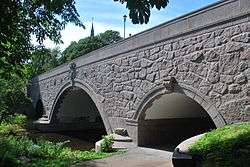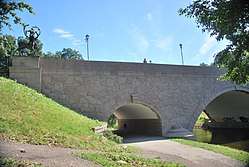Ankerbrua
Ankerbrua is a bridge located in the district of Grünerløkka in Oslo, Norway.[1][2]

East side of Ankerbrua over Akerselva

West side Ankerbrua over Akerselva
.jpg)
Kvitebjørn Kong Valemon sculpture
History
Ankerbrua was built over the Aker River (Akerselva) to serve as an extension of Torggata along Ankertorget with Søndre gate. The former wooden bridge had been constructed in 1874. It was replaced by the current granite structure in 1926. [3]
The bridge has been nicknamed the Fairytale Bridge (Eventyrbrua) due to its four sculptures, one in each corner. These sculptures were designed by Norwegian sculptor and artist, Dyre Vaa. Cast from bronze in 1937, each figure represents a different Norwegian folk hero from Norwegian Folktales.[4] [5] [6]
The motifs are
- Kvitebjørn Kong Valemon - who was cursed to spend his days as a polar bear after he refused to marry a wicked witch
- Per Gynt - a legendary deer hunter from Gudbrandsdalen.
- Kari Trestakk - who escaped her evil stepmother on the back of a great blue ox.
- Veslefrikk med fela - a young man who gets three wishes from a troll.
gollark: They should simply stop wanting that.
gollark: Stop being wrong, then. Anyway, it seems quite mean to punch people like that, as they generally do not like being punched.
gollark: That sounds particularly mean.
gollark: However, I disagree.
gollark: They aren't actually mutually exclusive, bee.
References
- Ankerbrua – Fairytale bridge (SpottedbyLocals.com)
- Ankerbrua ei eventyrbru (Norsk Teknisk Museum)
- "Ankerbrua". Kulturminnesøk. Retrieved November 1, 2017.
- "Ankerbrua". lokalhistoriewiki.no. Retrieved November 1, 2017.
- Dyre Vaa (Store norske leksikon)
- Anne Haugen Wagn: Dyre Vaa (Allkunne AS)
External links
- Peer Gynt statue by Dyre Vaa on Ankerbrua
- Kari Trestakk statue by Dyre Vaa on Ankerbrua
- Kvitebjørn kong Valemon statue by Dyre Vaa on Ankerbrua
- Ankerbrua picture gallery
This article is issued from Wikipedia. The text is licensed under Creative Commons - Attribution - Sharealike. Additional terms may apply for the media files.